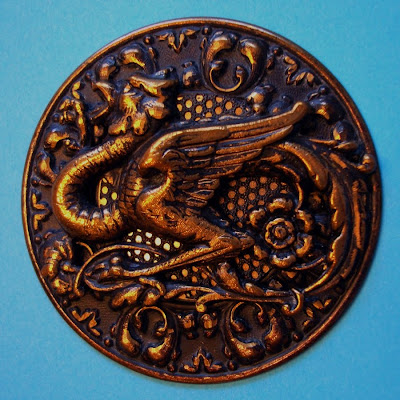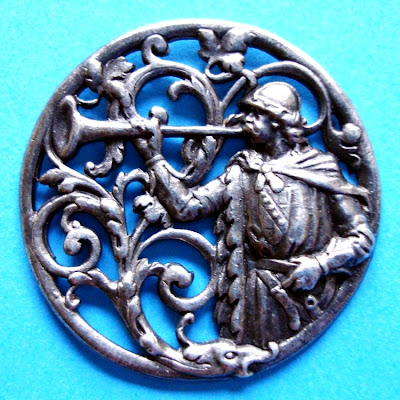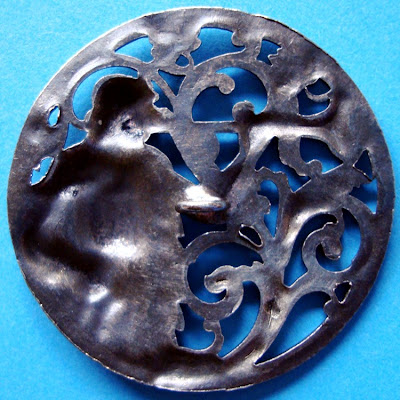Thursday, December 17, 2009
Tuesday, December 1, 2009
Trumpeter of Sakingen - High Relief
Brass and Tinted White Metal
Circa 1880s
NBS Large
Japanned Back
This Trumpeter of Sakingen picture button is atypical. See the Trumpeter of Sakingen below for another rare example, and for a link to the trumpeter's story. The front of this Trumpeter of Sakingen is a brass escutcheon mounted on a tinted white metal background. With his high boots and dashing plumed hat, Werner, the trumpeter, plays for the lovely Margaretha, and calls her to the window.
Image and Text © 2009 Anne AKA Once Upon A Button
Monday, November 30, 2009
Trumpeter of Sakingen
Stamped and Pierced Brass
Cut-Outs, Shiny Steel Liner
c1880s
NBS Large
Japanned Back
The Trumpeter of Sakingen is a common button design, but this version is not a common button. Note the cut-outs for the half moon, the city windows, and the waters of the Rhine River. It is a three part stamped, tinted, and pierced brass button, with a shiny metal liner, a japanned back, and a silver rim. I paid about six dollars, but I've seen the same button priced at fifty dollars. There is a cut-out for a full moon in an even rarer version.
This button is another great example of the link between art, design, and popular culture. You can read the detailed story of The Trumpeter of Sakingen within the text of the Legends of the Rhine by H. A. Geurber (New York: A. S. Barnes & Co, c1895) found at the Internet Archive. Section 316 through 321 is Guerber's summary of the original poem, The Trumpeter of Sakingen by Scheffel. The story was made into an opera by Nessler, which is probably the reason for this button design's wide popularity.
Image and Text © 2009 Anne AKA Once Upon A Button
Tuesday, November 17, 2009
Knight with Mace and Shield
c1880s
NBS Large
Tinted Stamped Brass
Three Piece Button
Japanned Back
I purchased this button knowing the knight's shield is dented. Some of my buttons I'm happy to accept with damage, if the price is right, and the damage fits the character of the button and the scene it depicts. I might expect a battle weary knight to have a dented shield.
The button is made of stamped brass. It is constructed of a front, a rim, and a japanned back. Note the scaled armor that almost makes him look like a Roman soldier, rather than a medieval knight, but the mace and the decorated shield place him in a later time.
Image and Text © 2009 Anne AKA Once Upon A Button
Labels:
Armor,
Arms and Armor,
Brass,
Helmet,
Japanned Back,
Knight,
Mace,
Medieval Theme,
Metal,
Picture Button,
Shield,
Three Piece
Thursday, November 12, 2009
Medieval Collection II

c1880s
Look forward to these buttons and more, in upcoming posts. This is a "working" card of buttons, not a permanent display, the shanks poked through archival card stock. Some of my favorites include the King Arthur buttons, the Walking Man, the Dragon, the Fabulous Creatures, the Trumpeter of Sankingens, the Castles, the Scottish Chiefs, the Crusader Knight, the Jester, the Medieval Villages - I believe I've named them all! If you click on the image, you will see them in greater detail.
In future posts, they will be featured individually, with sharper focus and a photograph of their button backs. If you click on the label, Medieval Theme, below this post, you will view amazing buttons of Knights, Ladies, Minstrels, and Fabulous Creatures.
Image and Text © 2009 Anne AKA Once Upon A Button
Thursday, October 22, 2009
Love's Messenger
Bird Delivering a Letter
to a Woman at a Window
Textured Background
NBS Large
Stamped and Pierced Brass
c1880s
Button Back
This wonderful button depicts a woman at a window receiving a letter from a swallow. The button is made of stamped and pierced brass with a textured background. The brass is tinted black to create a nighttime scene. Notice the ornate window frame, the city rooftops and the clouds. I owe the title of this button and additional information to a member of the National Button Society, who looked the button up for me in the Big Book of Buttons. Thank you, Janelle!
Image and Text © 2009 Anne AKA Once Upon A Button
Saturday, October 10, 2009
Two King Arthur Buttons with Cut Steels
Knight with Shield and Sword
Stamped and Pierced Brass
Cut Steels in 4 Sizes
NBS Large
c1880s
 King Arthur - Button Back
King Arthur - Button Back King Arthur
King ArthurKnight with Shield and Sword
Stamped and Pierced Brass
Cut Steel Border
NBS Large
C1880s
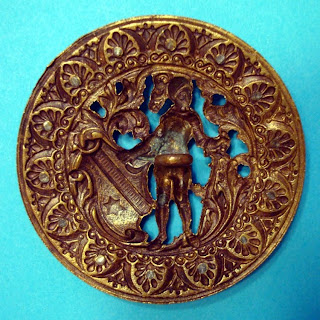 King Arthur - Button Back
King Arthur - Button Back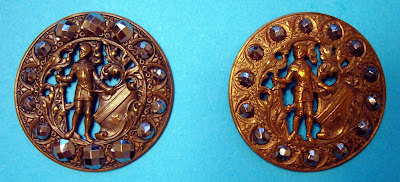 Two King Arthurs
Two King ArthursStamped and Pierced Brass
Fancy Borders
One with 4 Sizes of Cut Steels
One with Same Size Cut Steels
 Two King Arthurs - Button Backs
Two King Arthurs - Button BacksThese two buttons demonstrate how the same button die can result in buttons with similar but varied finishes and embellishment. The design is identical to a button also known as King Arthur featured in an earlier post, that is equally impressive, but without the cut steel border.
One of the things I enjoy about button collecting, is the way each button-- based on the original finish, the actions of aging, and whether someone has polished the button through the years-- develops its own character.
The buttons are made of one piece stamped and pierced brass, with a faceted and riveted cut steel border. The first King Arthur has cut steels in four graduated sizes, and the brass is muted and warm. The second button has a cut steel border with steels all of the same size, with the bright effect of polished brass. Of the two, I enjoy the first button the most, but my favorite of the three, in terms of patina, is the one without cut steels.
King Arthur wears a full suit of armor and a plumed helmet. He grips his sword, Excalibur, and a shield decorated with a six pointed star and a half moon.
Image and Text © 2009 Anne AKA Once Upon A Button
Labels:
Armor,
Armour,
Arms and Armor,
Brass,
Cut Steel,
King Arthur,
Knight,
One Piece,
Openwork,
Picture Button,
Pierced,
Shield,
Stamped,
Sword
Thursday, October 8, 2009
Falcon Hunter: French White Metal
 Falcon Hunter
Falcon HunterStamped and Pierced
French White Metal
NBS Large
c1940s
 Falcon Hunter - Button Back
Falcon Hunter - Button BackThis "falcon hunter" is a poor imitation of the original Falcon Huntress from the 1880s, yet the detailed design is attractive, including the fancy diamond border, the rider's flamboyant clothing, and the castle in the background. The stamped and pierced button is made of French White Metal, c1940s.
Image and Text © 2009 Anne AKA Once Upon A Button
Labels:
Bird,
Falcon,
Falcon Hunter,
Falconry,
French White Metal,
Openwork,
Picture Button,
Pierced,
Stamped
Sunday, October 4, 2009
King Arthur: Knight with Cut Steel Border
Knight Wearing a Helmet
Stamped and Pierced Brass
c1880s
NBS Large
This detailed King Arthur wears a plumed helmet. He has a distinguished face. The button is one piece stamped and pierced brass. The fancy border is embellished with 14 faceted and riveted cut steels. I like the dark patina. Sadly, someone at some point, cut the button's shank, leaving the loop elongated and broken. I knew this when I purchased the button, so I was happy with the button find, since I've never seen another like it.
Image and Text © 2009 Anne AKA Once Upon A Button
Friday, October 2, 2009
Mother and Daughter Dragons with Cut Steel Bodies
Fabulous Creature
Mother and Daughter Buttons
NBS Small, NBS Large
c1880s
Mother and Daughter Buttons
Japanned Back
Buttons of the same design in two sizes, one larger and one smaller, are known in the "button world" as Mother and Daughter buttons. Often, some aspects of the "daughter" button are less distinct, as in the border of the smaller button, but the brass escutcheon dragon/cockatrice figures, and the dragon's cut steel bodies, are nearly identical, right down to the rooster comb, the snake-like neck, the open beak, and the detailed feathers.
The button depicts a version of the evil cockatrice, half serpent and half rooster, evolved in the middle ages from the concept of the basilisk. For more information on the cockatrice, and to compare the button's designs, see my earlier post, Fabulous Creature: Screen Back Dragon/ Cockatrice. The smaller of the two buttons is also pictured in my post, Dueling Dragons with Cut Steels.
Image and Text © 2009 Anne AKA Once Upon A Button
Thursday, September 24, 2009
Landsknechts Trumpeter: Antique Picture Button
with Short Sword and Shield
c1880s
Stamped and Pierced Brass
NBS Large, 1 7/16"
The medieval trumpeter is made of stamped and pierced brass. Note his curled hair, his puffed and slashed doublet and hose, ruffled sleeves, and the plumed feathers in his cap, the dress of a German Landsknechts mercenary soldier. He adorns himself with a short sword and a decorated shield, and his trumpet with a plain, unfurled banner. The actual button is a uniform golden tone, but the photograph, with its slightly reddish cast, shows the elaborate detail.
Image and Text © 2009 Anne AKA Once Upon A Button
Labels:
Armor,
Arms and Armor,
Brass,
Hat,
Landsknechts Soldier,
Medieval Theme,
Metal,
Music,
Musical Instrument,
NBS Large,
One Piece,
Openwork,
Picture Button,
Pierced,
Shield,
Stamped,
Sword,
Trumpet
Monday, September 21, 2009
Fabulous Creature: Screen Back Dragon/ Cockatrice
Screen Back Dragon/ Cockatrice
NBS Large
Extra Large, 2" Wide
c1880s
Steel Metal Liner
Tinted Two Piece
Dragon Escutcheon
Screen Back Dragon/ Cockatrice
Button Back
This truly Fabulous Creature is a 2 inch wide, extra large antique clothing button, circa 1880s, depicting a dragon-like creature known as a cockatrice. It would be categorized as an NBS large, but a button of this size is rare. The screen back is also rare. The main part of the button is made of one piece brass, with the front of the button constructed of the steel liner, the screen back, and the brass escutcheon of the fabulous creature.
The photograph barely captures the majesty of this impressive button. The shiny metal liner is perfect, twinkling like the shiny bright metal you can observe in the photograph below the creature's breast, in contrast to the screen back, which is tinted almost black. In dragon mythology, a cockatrice is a cross between a rooster and a snake, evolved from the concept of the basilisk. Note the creature's beak, comb, claws, and feathers, and his otherwise dragon-like appearance.
The flower tail is also a distinguishing mark, not because it bears any relation to a cockatrice, but because many button collectors are enthralled with owning "flower tail" dragons, the flower at the end of the tail added as an embellishment. Special thanks to my friend, Christine, for letting me know some of the dragons on my buttons are the "evil" cockatrice, lain by a rooster but hatched by a toad, its very glance capable of killing animal or human.
Image and Text © 2009 Anne AKA Once Upon A Button
Saturday, September 12, 2009
Genesis of a Button Collector/ Button Collecting Advice
Antique Picture Buttons
I became a button collector when I was sixteen years old, visiting my grandmother in her two story wood frame house in upper Michigan, just before she sold it. I remember sorting buttons from a huge glass jar on the small table in her kitchen. She had diminutive metals and silvered glass, twinkle buttons, fun plastic faces, three large Syroco flower buttons, reverse painted clear glass, and Mexican hats. She had a large black crochet button, a row of tiny brass on a remnant of silk, dyed mother of pearl, bakelite ball buttons in yellow and red, and round black glass with faceted rhinestones. It's possible a few buttons came with her when she emigrated from Finland. They all became mine.
Years later, I began looking for buttons in antique shops and at antique shows. I was about twenty-five when I acquired a small button stash from a shop going out of business, including heraldry buttons, transportation buttons, and a set of brass palm trees with silver gilt, all for $5 plus $3 for the trees, because I didn't know what they were worth, and neither did the dealer.
Years later, I began looking for buttons in antique shops and at antique shows. I was about twenty-five when I acquired a small button stash from a shop going out of business, including heraldry buttons, transportation buttons, and a set of brass palm trees with silver gilt, all for $5 plus $3 for the trees, because I didn't know what they were worth, and neither did the dealer.
After that, my success at shops and shows was limited. At shows, I'd sometimes find a few buttons in a jewelry case, but they were often common or damaged and outrageously priced, partly because the dealers were generalists. Worse is when I found only plain plastic buttons in a pickle jar with a calico bonnet, passed off as "vintage" or "collectible," or 1970s plastics in a dusty box or a rusted tin. (Though my brother once found me one of those pickle jars and it contained some of my favorite buttons, several black glass and a carved mother-of-pearl.)
I visited the Lightner Museum in St. Augustine, Florida, and I was fascinated by what to me, at the time, was an incredible collection. (It still is, but I own buttons now, in some categories, to rival it!) I started purchasing books about buttons, and devouring the illustrations. I've never had the chance, to this day, to visit the National Button Society's annual button conference, or my state sponsored show, but, if you can afford it, that is a way to purchase buttons from reputable, knowledgeable, and enthused button dealers.
It's not my intention to promote commercial sites, but e-bay is where I've found most of my buttons. It's important to educate yourself about button designs and materials, and to bid cautiously as you are learning, and not to get caught up in the frenzy. Most button designs, not all, are common enough they will come up for purchase again; and if they don't, there's always another design to satisfy your artistic leanings; and there are some rarer buttons that only the truly rich or the insane can afford.
There are also button dealers that sell from their own sites, but I've found the fixed prices are not always reasonable. It's possible, on e-bay, to sometimes get a deal, or at least a fair price, but it's also incredibly easy to pay way too much on a button that may indeed be beautiful, but common.
As in all antiques, condition is everything. Only bid on a damaged button if you love the design, you're planning to keep it for yourself, and the price is right. When buying a button, I always ask myself, would I pay this price if it were a piece of jewelry?
Regarding jewelry made of buttons- never, never, never buy a piece of jewelry, where the button's shank has been removed- it's like separating Lyra from her daemon. The button will no longer have any value as a button, and a piece of history will be forever destroyed. Almost always, the value of the button, as a button, is greater than the ephemeral button conglomerate the jewelry has become.
Another way to develop your collection, is to ask family members and friends if they or their relatives have any clothing buttons from an earlier generation. Though buttons from the mid to late twentieth century will never rival those of the nineteenth and the turn of the century, modern buttons from the 1920s through the 1960s can be a lot of fun with a surprising variety of subjects and materials, including the Art Deco era and early types of plastics like bakelite and extruded celluloid.
I started this blog as a celebration of antique clothing buttons, and a place to feature the best of my permanent collection, photographing both the front and the backs of the buttons, and at a high resolution, so the buttons can be studied for their artistry and construction. For additional and more comprehensive sources of information on buttons and button collecting, I've provided links to button organizations and museums on my sidebar, including a link for the National Button Society (United States), and the British Button Society.
Soon, I'll be posting a bibliography of the button books I own, indicating which of the books are currently in print or likely to be available in libraries. The books are a joy in and of themselves, so if you can't afford buttons or don't have the space to store them, you might decide instead to buy a book, or to borrow them from your local library, or through interlibrary loan. Still, a picture of a button on a printed page is not the same as a button you can hold (carefully, by the edges, so not to transfer moisture or oils to the surface!).
Image and Text © 2009 Anne AKA Once Upon A Button
Monday, September 7, 2009
Falcon Huntress with a Pierced Border
Stamped and Tinted Brass
Pierced Border
c1880s
NBS Large, 1 3/8"
If this Falcon Huntress seems familiar, it is because she is patterned after the Falcon Huntress I featured in an earlier post. Both share the same basic design. The Falcon Huntress rides side saddle as she leaps a fence, her loyal hound running beneath it. She wears a high necked gown and a hennin with a flowing veil. This button is a stamped and tinted brass disc framed by a stamped, tinted and pierced brass border. I enjoy both buttons, but my favorite of the two is the version with the cut steel border.
Image and Text © 2009 Anne AKA Once Upon A Button
Saturday, September 5, 2009
Dueling Dragons with Cut Steels: Antique Picture Buttons
with Cut Steel Body
c1880s
Two Piece
Tinted Brass
Japanned Back
NBS Small, 11/16"
 Dragon with Cut Steels
Dragon with Cut Steelsc1880s
One Piece
Tinted Brass
NBS Small, 11/16"
 Dueling Dragons with Cut Steels
Dueling Dragons with Cut Steels Dueling Dragons - Backs
Dueling Dragons - BacksThese buttons are great examples of the art of button construction and design. They both depict dragons (AKA fabulous creatures) with cut steels. The dragon with a cut steel body is made in three main parts with a front, a back, and a rim. He is a depiction of a cockatrice (without his legs or rooster comb). The second dragon is a one piece stamped brass button with four riveted and faceted cut steels. The term "fabulous creature" applies to all dragon or dragon-like creatures depicted on buttons. When placed together, the two creatures appear to be in opposition. I'm fascinated by the exceptional detail on buttons that are just shy of 3/4".
Image and Text © 2009 Anne AKA Once Upon A Button
Labels:
Brass,
Cockatrice,
Cut Steel,
Dragon,
Fabulous Creature,
Faceted,
Japanned Back,
Metal,
NBS Small,
One Piece,
Picture Button,
Riveted,
Three Piece
Wednesday, September 2, 2009
Immo and Hildegard: Story Button
Story Button
Stamped and Pierced
Tinted Brass
Shiny Metal Liner
NBS Medium, 1 3/16"
c1890s
from Gustav Freytag's The Wren's Nest
Printed in the book
Brewer, Ebenezer Cobham, 1810-1897
Character Sketches of Romance, Fiction and the Drama.
A Revised American Edition
of the Readers' Handbook Volume II (1892)
Artist - H. Kaulbach
Printed in the book
Brewer, Ebenezer Cobham, 1810-1897
Character Sketches of Romance, Fiction and the Drama.
A revised American Edition
of the Readers' Handbook Volume II (1892)
There is a beautiful story to go with this button. The button is known as Immo and Hildegard, or, the Lover's Meeting. It is a stamped and pierced brass button, mounted over a shiny metal liner, with a japanned back. At 1 3/16", it is 1/16" shy of being an NBS Large. The streaks in the silver liner are an artifact of the photograph, and do not appear on the actual button. If you click on the image above, you can read about Immo and Hildegard. The full text is available from the The University of Wisconsin's Digital Collections, as printed in Character Sketches of Romance, Fiction and the Drama, circa 1892. The entry starts on Page 204 and continues on Page 205, with the print and a frontispiece sandwiched between them.
Freytag's story of Immo and Hildegard, and H. Kaulbach's image are in the public domain. I wonder if H. Kaulbach had anything to do with the design of this button, since it is clearly patterned after the woodcut illustrating Freytag's story. I also haven't been able to determine how long a work the original volume, The Wren's Nest, might be, because what is printed in Character Sketches is flowery and romantic, but brief. Freytag, a controversial German novelist and playwright, lived from 1816-1895. Kaulbach is probably Hermann Kaulbauch (1846-1909), a German artist best known for his portraits of children.
Image and Text © 2009 Anne AKA Once Upon A Button
Tuesday, September 1, 2009
Guest Book
If you have one or more buttons you treasure, you are a button collector. If you appreciate the design, artistry, and construction of antique buttons, you are a button fan. Either way, please sign this guest book by writing a comment, and let everyone know a little about your passions.
Do you own family heirloom buttons? How did you begin button collecting? What types of buttons do you collect? What do you enjoy most about antique buttons? If you were to design a picture button, what theme would you choose to depict? What is your favorite button material? What is your favorite antique button era? If you've saved buttons from your childhood, what memories can you attach to them?
This moderated guest book is open to whatever information you'd like to include. And comments on individual buttons are always welcome!
Do you own family heirloom buttons? How did you begin button collecting? What types of buttons do you collect? What do you enjoy most about antique buttons? If you were to design a picture button, what theme would you choose to depict? What is your favorite button material? What is your favorite antique button era? If you've saved buttons from your childhood, what memories can you attach to them?
This moderated guest book is open to whatever information you'd like to include. And comments on individual buttons are always welcome!
Sunday, August 30, 2009
Romeo and Juliet: Medieval Couple
Art Nouveau
Stamped and Pierced
White Metal
Couples Button
NBS Medium, 1 1/16"
 Romeo and Juliet - Back
Romeo and Juliet - BackThis button is known as "Romeo and Juliet." It is a wonderful depiction of romantic "courtly" life. A fancy dressed Romeo presents a parrot or a cockatoo to his love. The actual button is barely over 1" wide. It is a stamped and pierced white metal button, probably made in the Art Nouveau era. The gentleman wears tights, pointed shoes, puffed sleeves and a plumed hat. The lady wears a lovely gown with a long train, and a hennin with a flowing veil. Note the patterned floor, and the framed effect of the button's design, as if it were a woodcut or an illustration for a book. In natural light, the actual metal is a duller silver than a French white metal button, with just a hint of "orange" patina.
Image and Text © 2009 Anne AKA Once Upon A Button
Labels:
Art Nouveau,
Bird,
Couple,
Hat,
Hennin,
Lady,
Medieval Theme,
Metal,
NBS Medium,
One Piece,
Openwork,
Parrot,
Picture Button,
Pierced,
Romeo and Juliet,
Scene,
Stamped,
White Metal
Saturday, August 29, 2009
Trumpeter: French White Metal Button
Stamped and Pierced
French White Metal
c1940s
NBS Large, 1 7/16"
The trumpeter wears a helmet, a cloak, decorated sleeves, and a sword strapped to his belt. He may be sounding a charge. I enjoy the button's attention to detail, including his face, the position of his body, and the folds in his clothing, but compared to the brass buttons of the late nineteenth century, French white metal buttons from the 1940s appear "cobbier," and the embellishments are more "busy" than accomplished. Still, it's a great button with a great design. (Also, I'm showing the buttons three to five times their actual size, exaggerating any flaws in design or workmanship.)
Image and Text © 2009 Anne AKA Once Upon A Button
Labels:
France,
French White Metal,
Helmet,
Instrument,
Medieval Theme,
Metal,
Music,
One Piece,
Openwork,
Picture Button,
Pierced,
Stamped,
Trumpet
Friday, August 28, 2009
Battle Knight on a Charging Horse: French White Metal Button
Stamped and Pierced
French White Metal
c1940s
NBS Large, 1 1/2"
The charging knight wears full battle armor, right down to his spurs. The button is made of stamped and pierced French white metal. Note the surface detailing on the knight's armor and his shield, and on the horse's blanket. I enjoy the sense of motion in this button. As far as I know, it does not copy an earlier antique, and is a unique design, made in France in the 1940s. If anyone reading this post knows anything more about this button, or French white metal buttons in general, please add a comment. I know how to recognize one, and those I've purchased have been identified as French white metal, but I don't know much more about them.
Image and Text © 2009 Anne AKA Once Upon A Button
Thursday, August 27, 2009
Knight at the Door Bearing a Shield
c1880s
NBS Large, 1 3/8"
One Piece Stamped Brass
Riveted Cut Steels
Border with Screw Heads
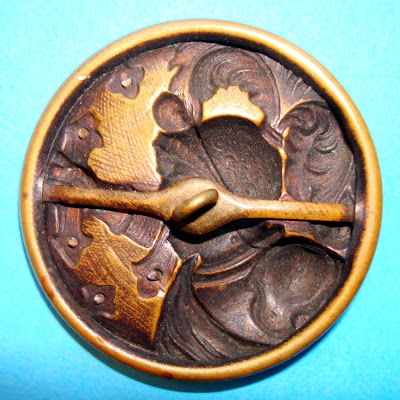 Knight at the Door - Back
Knight at the Door - Back Knight at the Door - Three Brothers
Knight at the Door - Three Brothers Knight at the Door - Three Brothers - Back
Knight at the Door - Three Brothers - BackThis button is often referred to as: Knight at the Door, even though he is actually a knight bearing a shield. I love this button. I first acquired the button without cut steels, and of the three, I enjoy the first button's "patina" the most. The button is slightly concave, and has a definite sense of three dimensionality, with the knight standing in relief from his textured background. He wears chain maille, gauntlets, a shoulder pauldron, a gorget, and a plumed helmet.
Five faceted and riveted cut steels decorate this one piece stamped brass button. The "brother" buttons, even the NBS small, exhibit the same quality of workmanship, and the same applied shank. Note the screw heads in the border and the rich detailing of the knight's mustached face and his armor.
Image and Text © 2009 Anne AKA Once Upon A Button
Labels:
Armor,
Armour,
Arms and Armor,
Border,
Brass,
Chain Maille,
Cut Steel,
Faceted,
Helmet,
Knight,
Medieval Theme,
Metal,
One Piece,
Picture Button,
Riveted,
Shield
Subscribe to:
Posts (Atom)


















